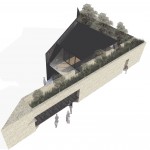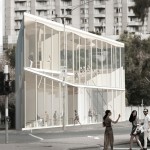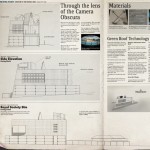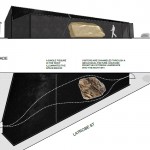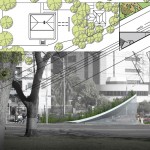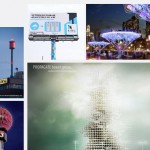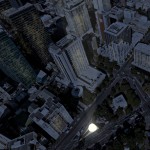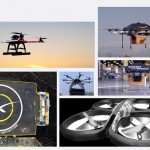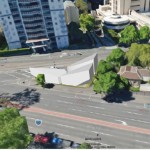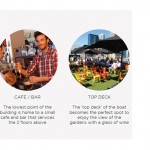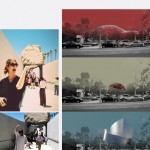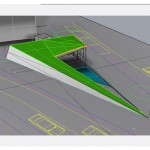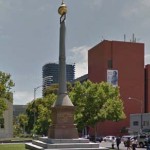Crowdsourcing the BoM Site – Visions, Concepts and Ideas for “1 Victoria Street, Melbourne”
Back in June we sought bright ideas from the Melbourne community for the small yet very prominent plot of land formerly occupied by the Bureau of Meteorology (BoM) through an article in The Age and subsequent radio discussion.
We have been truly amazed by the wealth of creative thinking Melburnians have demonstrated in coming forward with ideas for our little block of land! The process for making a submission was necessarily broad, the terms vague, and attempted to limit conceptual work to only a few pages, providing some idea of the embodied cost of construction and likely return on investment. The interpretation of these parameters by different agencies was almost as creative as their actual content.
Overall, this exercise in crowdsourcing has returned a broad palette of ideas in a variety of formats. Some have proffered a few pithy lines, some have agonised over a three page, high definition submission that could fill three major billboards, while still others have provided up to six separate concepts! All of them, creative, thoughtful, and a real delight. In particular, we have had a few individuals and agencies who have really engaged with the purpose and mission of the Royal Society of Victoria to promote the practice and understanding of science in Victoria, finding ways to align concepts with our key goals. For this, we are particularly grateful.
There are repeated themes of sculptures, iconic monuments, lecture theatres, green rooftops and cafes, along with didactic displays and education centres relating to the sciences. Some present architectural elements that are in themselves highly inclusive of technology. Some are simply unique! These concepts are presented below in three categories for your interest and review.
Submissions are offered here as an excellent way to get a conversation started with the community, City and State. We do look forward to progressing the discussion with a firm view to securing a source of enduring revenue for science promotion, outreach, policy and literacy in the State of Victoria. If the end result is an iconic concept that clearly brands Victoria as a major centre for growth and prosperity in the Australian science and technology sector, then all the better.
– Mike Flattley, Executive Director
Category One: Submissions from Architects, Designers and Agencies
Category Two: Individuals & Companies
Australian Bell Pty Ltd – RSV Technology Chime
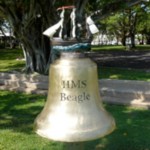 “I would like to propose an installation of harmonic bells in the triangular space. These bells are a revolutionary design for the most musical bell yet invented, their design being only possible through the use of digital design tools including Finite Element Analysis, 3D printing (used as foundry patterns), modern casting technology and developments in metallurgy. They are one of the fruits from the science and technology of our age, just as bell founding has historically been a watermark of the technical and scientific advancement of every age and civilization before our time, given the precision required to tune musical frequencies from these ( sometime, extremely large ) cast vibrating forms.
“I would like to propose an installation of harmonic bells in the triangular space. These bells are a revolutionary design for the most musical bell yet invented, their design being only possible through the use of digital design tools including Finite Element Analysis, 3D printing (used as foundry patterns), modern casting technology and developments in metallurgy. They are one of the fruits from the science and technology of our age, just as bell founding has historically been a watermark of the technical and scientific advancement of every age and civilization before our time, given the precision required to tune musical frequencies from these ( sometime, extremely large ) cast vibrating forms.
The C major octave of 8 harmonic bells, rung manually, encourages members of the community to create gentle and sonorous musical performance on site, either singularly or in groups. This interactivity and participatory experience brings individuals in the community together to share their own creativity and to appreciate the creative imaginations of their fellow citizens.
This “Science meets Art” vision for the site can include bronze statues atop each bell of the major scientists on whose shoulders we stand. This might include Pythagorus, Galileo, Newton, Darwin, and Hawking amongst the pantheon of great scientific minds. A musical instrument, such as a chime of bells, depends on the different pitch of each bell to create musical expression. A chime of bells speaks to this harmony of diverse parts, like ideas and theories bought into ever finer resolution when shared and debated, with now and then new compositions, much like the shifting of paradigms, finding favour. There is a vital, indeed essential, linkage between ‘Science and the Arts’ at play in this set of 8 Harmonic bells within the triangular space in Melbourne.”
Modern Learning P/L – Glow Worm Conservation Centre & Childcare Facility
 The glow worm cave and conservation centre will feature the endangered Mt Buffalo colony glow worms which will initially be raised via special incubators inside the centre prior to them being raised directly in the visitor display area of the conservation centre.
The glow worm cave and conservation centre will feature the endangered Mt Buffalo colony glow worms which will initially be raised via special incubators inside the centre prior to them being raised directly in the visitor display area of the conservation centre.
The centre will lend itself to be an experiential learning tourist attraction, perfect for school groups and those eager to see the beauty of such fascinating creatures. Furthermore, the conservation centre will provide permanent employment for 2-3 persons.
Additionally, the conservation centre will display research and information pertaining to a variety of bioluminescence species, including:
• Various species of glow worms
• Luminous mushroom species (Neonothopanus namibi)
• Luminous Ghost Fungus.
The demand for quality childcare services within the CBD continues to grow. Having operated a childcare centre as part of our business portfolio, Modern Learning Pty. Ltd. are confident that the location is ideal for the establishment of a new child care centre.
The childcare centre will provide high quality childcare services for clients within the CBD, and will result in the creation of 5-7 new full time roles.
Nalin Sharda – Zero to Infinity (ZIF) Park
“The key installation, positioned at the apex, needs to draw attention to the ZIF Park. Infinity symbol standing vertically with the lower oval closed, representing zero, and the upper oval with an open end towards the sky, representing infinite possibilities, will not only demand attention, but also convey the theme of the park.
Behind the infinity symbol, a series of steps incorporating digits 1 to 9, rising from ground towards the sky, will point to the power of the decimal number system: its ability to count ad infinitum, with just ten symbols.
Other installations can be spread around the park with inscriptions that depict the temporal and spacial development of number systems around the world. Some of these can provide opportunity to sit down, as if on a workstation, to work or to have a snack. A large TV can also be used to show the history of number systems.
Binary number system has become equally important in this digital era. Some of the installations can focus on the Binary number system. Additionally, a walk-over game can be placed in the middle of the park (similar to the chess shown in Fig. 3) to show the correlation between the binary and decimal systems. I have designed such games, and will be happy to elaborate.”
Gary Chan – The Science Portal
“Imagine, entering the Society’s doors and ‘out’ into the garden. Imagine that this space, this ‘garden’ that the visitor has ‘entered’, is a different space, becoming incredibly larger, more expansive, and more complex than actuality.
The assumption here is that this would be a bigger project involving created and renovated spaces within the land occupied by the Society. Such space(s) would be constructed and designed to stimulate the senses and to provide passage to the annals of science past, present and what may be imagined for the future.
In addition, rooms could be created that immerse visitors and viewers into a range of environments, from natural and microscopic environments to deep space, oceans, and to consider topical issues such as climate change and new frontiers to science. Indeed, the digital world could be re-imagined in a sensory and engaging environment, which may lead to new ways of thinking for problem-solving across all sectors.”
Rob Gell – Aluna, Tidal Powered Moontime
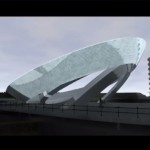 “Have a look at www.alunatime.org . I know the artist; she’s been to Melbourne; I’ve tried to build Aluna on Central Pier and we just missed out getting one into Darling Harbour in Sydney.”
“Have a look at www.alunatime.org . I know the artist; she’s been to Melbourne; I’ve tried to build Aluna on Central Pier and we just missed out getting one into Darling Harbour in Sydney.”
Daniel McDiarmid – Vertical Farm and Research Centre
“I have for some time been exploring the concept of inner city vertical (4‐10 storeys) commercial farm and a research facility for examining increased food production for growing cities. The concept is outlined by Dr Dickson Despommier and is so much more than a roof garden.
The idea is to have office space on the inside and crops produced on the outside, inside and on the roof. My concept is to have a research group that examines the best crops for Melbourne’s climate, this could then be used throughout similar cities in the world.
The drawback has always been getting land at a reasonable price and I would see the triangle as a site to test the concept. I wish to stress this is NOT a commercial venture for me but a scientific experiment in urban planning and construction.”
Neil McPhee – A Dedication to Pythagoras
“Perhaps the Royal Society could pave the triangular area with a triangle (what else?) and incorporate into the paving the interesting mathematical bits and pieces that triangles give rise to? I have seen this sort of thing done before, but cannot recall where. I think it may have been in Bogota.
A statue of the Greek philosopher Pythagoras could be handily located on a plinth in the middle of the area (I assume triangles have a middle) with some interesting bits about the history of triangular mathematics etched into it.”
Richard Olive – Polyhedron Park
“It is a curious mathematical fact that there are just five regular polyhedra. They are pleasing shapes to the eye. I would propose that solid models of the five objects, say 1.5 to 2.0 metres in dimension be scattered more or less randomly on the lawn (fixed to flush concrete bases, of course, to facilitate mowing).
Then, on one side, say Latrobe Street, have free‐standing block letters (1 metre high??) saying JUST 5. The only explanation would be given on a brass plaque set flush with the lawn, adjacent to the letters. The idea is to create a puzzle for those driving by, and to reward those curious enough to take a closer look. Then facing the other street, say Victoria St, have similar free‐standing letters announcing Euler’s Formula for Polyhedra, V – E + F = 2. Again, limit explanation to a brass plaque.
Now, what to do with the shed? In it, and possibly also in a couple of identical new sheds either side of the existing one, house a computerised “game”, where the visitor may select on a touch screen any one of the five regular polyhedra, and slice through it with an imaginary plane saw‐cut at any selected angle. The polyhedron will fall into two nonregular polyhedra, A and B. The computer will then instantly tally up the number of vertices (corners) V, edges E and faces F for both A and B. The visitor will be asked to calculate (V – E + F) for both A and B, and will be amazed that no matter how he/she has positioned the saw cut, he/she can arrive at no answer other than 2.
I’m sure that the exercise will be very fascinating for most young mathematicians, and others.”
Cynthia Karena – Outdoor Science & Technology Museum
“I’d like to suggest an interactive hands-on outdoor science and technology museum, where people can interact with science and tech in a fun way. Years ago I remember going to the science museum in Munich, and loving the way I could stick my hands through into the display cabinet and perform an experiment.
It’d be great to let the public play with instruments that measure, water wheels that can be turned to illustrate a scientific principle, do experiments such as dropping a small (controlled) piece of sodium on water to watch it race around) and mixing chemicals in a controlled volcano set-up, include robotics, and perhaps some meteorology equipment for people to play with (in a controlled way) as a nod to the land’s meteorological past.
And why not dig underground as well? Perhaps mining technology, paid for by mining companies perhaps… Or, CSIRO has a wonderful handheld laser scanner that can be used underground to produce 3D maps (http://www.csiro.au/en/Research/DPF/Areas/Autonomous-systems/Mapping/Zebedee).”
Rodney Wetherell – Sculpture Park of Famous Australian Scientists
“For the triangle I can think of nothing better than a sculpture commemorating the many achievements of Australian scientists – Oliphant, Eccles, Nossal, Burnet, Florey to name just a few. Last night I saw the play Waiting Room about the IVF work of Alan Trounson and Carl Wood – people like this deserve to be publicly remembered.”
Roz Girvan – Monument to Universal Suffrage
“I would dearly love for the contribution of our incredible pioneering women in democracy (and remember that this is universal ‐ they led the way for the world and spoke to American Presidents and the British Parliament!) to be honoured. I must also say that such a monument to universal suffrage must acknowledge that Aboriginal people did not get the vote at Federation and had to wait until 1967.
People take democracy for granted. It would be a good thing to have a place that honours the struggle for people to have their full rights as citizens.”
Malcolm Mathias – A Science & Weather Education Building
“My concept for this “triangle” involves a new two storey triangular building to match the architecture of the existing Royal Society of Victoria headquarters, which would have a green grass roof and a complete replica weather station on that green grass roof. The building could accommodate school groups in a small lecture theatre, a small shop selling weather related materials, a café and displays of weather instruments and historic weather events.
The lecture theatre would provide multi-media educational presentations designed specifically for primary, secondary and tertiary students, as well as the general public.”
Category Three: General Feedback, Quick Ideas and Comments
A small park
Could I suggest a narrow flagged path along the back of the triangle providing a shortcut between the two streets (since people will want to walk there anyway) and then a formal arrangement of garden & small fountain – open to the people , with no barb wire or high railing in sight , and no screening plants to invite hidden threats to anyone.
Oh and a few seats if there is room.
Good luck with your project,
Yours Sincerely,
Janis Lyell
A mini physic garden
My suggestion for the remnant triangle adjoining your property would be to turn it into a garden. Not just any garden, but a mini physic garden along the lines of Chelsea in London. In keeping with the building, educational and maybe open to public occasions on the odd summer evening for lectures or parties, thus revenue raising as well.
Nice to have the chance to offer an opinion. Good luck,
Dianne Ounapuu
A monster aquarium
An idea or fantasy which immediately comes to mind is a (one storey) monster aquarium (simply fish and plants – no bells and whistles) to encourage contemplation and joy.
No doubt it would cost a fortune to build/run/vandal proof, but if I had a fortune…..
Cheers
Julie.
A heritage weather instrument display
As the BOM have used the site for many years, why not have the BOM display the historical weather stations used on that site over the years.
Regards,
Ashley Wheare
A really good restaurant
I‘ve no doubt that many suggestions will be made, and I am not able to propose this as a viable project, nevertheless, the site is really tops for a really good restaurant, with it unparalleled views towards both the exhibition gardens and the city. I do hope that someone thinks of this,
Meanwhile, good luck.
Professor Phillip Hamilton
An alternative energy interactive display and park
How about miniature interactive display of sculpted wind, solar and water power in a green setting with some seating? Good wishes.
Mark (and Gillian) Clezy.
As soon as I saw the article in the age, I was reminded of this tiny house in Japan: https://www.youtube.com/watch?v=X5g0LuSkE-k
I am not suggesting that a house be built on the land, but using the tip of the triangle as a spiral staircase really opens up options. For example, it could be used to build an observation platform to get a good view of Carlton Gardens and the REB.
Dan Loudon
A food pyramid
For what it’s worth my idea for this triangle shaped plot of land would be to make it into a food pyramid. It is scientific; it is educational; it is a contemporary subject and it will benefit the public and engage people in a positive way. I imagine it as a series of sculptures of fruits, vegetables, cereals, sweets etc. It could be erected in 3D fashion or lying flat in a 2D fashion.
Best regards,
Chloe Bibari
A cottage garden
Hi Mike,
As a RMIT student in the 70’s my daily walk to the school of Design @ RMIT was walking past this unique triangular piece of land with the Bureau of Meteorology instruments contained behind the fence.
For me & no doubt thousands of others I have an emotive connection to this piece of land & what it represents & that was something iconic & a unique small space in a city before these current days of commercialism where nothing is sacred, & everything has to have a commercial return.
I would like to propose the following for your consideration.
PROPOSAL > that this iconic triangular island piece of land, formerly the location of the Bureau of Meteorology instruments, be returned to its original use prior to utilisation by the Bureau of Meteorology & that was as a circa 1860’s Victorian Garden attached to the original existing house.
This garden was probably a mixture of growing vegetables & flowers & i would like to see this returned as it was behind a timber Victorian fence that excludes the general public but allows them to see the garden over the fence. I am sure that the Melbourne City Council could include this in their garden maintenance program & in conjunction with the National Trust.
Please refer to the cottage garden @ HEIDI for inspiration as to what it could look like.
Maybe in return for doing this a Melbourne philanthropist could provide the Royal Society of Victoria with an annual subsidy in return for making this land available to the Victorian public, so a win, win for everyone & especially the residents of Melbourne & another example of why MELBOURNE is the Garden State.
Many thanks for your consideration of this idea, & should you believe that it has “legs” I would be happy to drive the concept on a voluntary basis.
Regards RICHARD HOPKINS FDIA.


